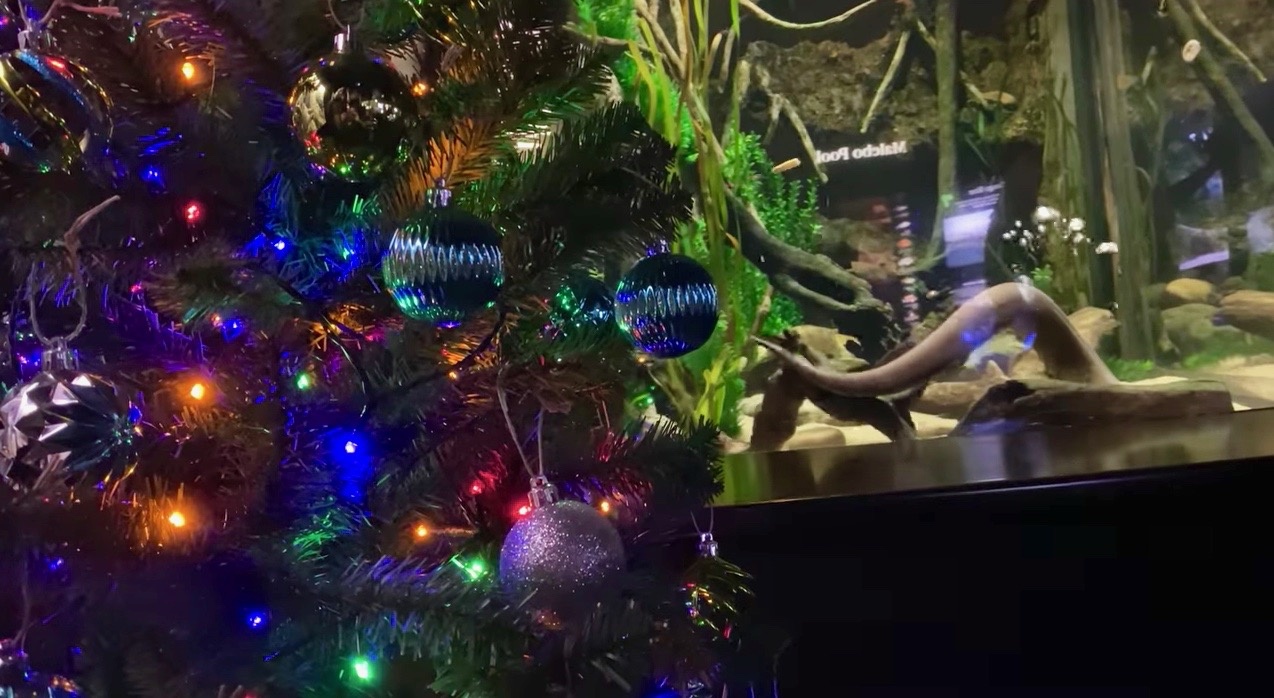
An Electric Eel Is Controlling the Lights on This Tennessee Christmas Tree

This electric eel is helping to control the lights on a Tennessee Aquarium Christmas tree. The Tennessee Aquarium
A Christmas tree at the Tennessee Aquarium has a shocking secret: its lights are triggered by the charges released by an electric eel.
The eel, Miguel Wattson, is already a star on Twitter, according to the Associated Press, and coders at Tennessee Tech University’s iCube center figured out how to translate his shocks into tweets like “SHAZAM!!!!” and “ka-BLAMEROO!!!!!”
This Monday, though, he tweeted something else. A video of his electricity making the lights on a tree near his tank flicker on and off.
ICYMI, here's a video of yours truly attempting to use my discharges to power the lights on a Christmas tree. (SPOILER ALERT ::: Of course I pull it off. My phenomenal cosmic — well, bio-electric — power is basically limitless.) pic.twitter.com/g4r5JPHWoH
— Miguel Wattson TNAQ (@EelectricMiguel) December 2, 2019
Miguel doesn’t directly power the tree, the eel’s caretaker Kimberly Hurt told NPR.
“There is a sensor directly in his exhibit that picks up when he produces electricity,” Hurt explained.
That sensor then “translat[es] when he’s producing electricity to the lights.”
The brightness of the lights varies based on what kind of shock Miquel produces. Electric eels produce high voltage shocks of up to 800 volts when they are stunning prey or trying to defend themselves. That means the tree is brightest when Miguel is eating.
Otherwise, eels produce shocks of around 10 volts in order to navigate and find prey despite their poor eyesight and the murky waters where they live, according to the aquarium.
During the rest of the year, the sensors in Miguel’s tank are hooked up to an amplifier and LED meter to let visitors know when he is sparking. It wasn’t difficult to hook the sensors up to a tree instead, and Hurt says they will bring the display back in future years.
“We want people to be interested in these animals and interested in protecting the waters that they live in,” Hurt told NPR.
Electric eels aren’t really eels. They are actually a kind of knifefish that live in the freshwater ponds and streams of the Amazon and Orinoco basins in South America, according to National Geographic. A study published in September revealed that what scientists thought was one species of electric eel is actually three, highlighting the extensive biodiversity of the Amazon region.
The fish can grow to be more than eight feet and 44 pounds, according to National Geographic. It is rare that their shocks kill humans, but they have the capacity to: multiple shocks can cause respiratory or heart failure. Miguel’s keepers wear gloves to keep themselves safe, the aquarium says.
The Tennessee Aquarium isn’t the first to bring the Christmas spirit to their electric eel display. The Living Planet Aquarium in Utah had a similar display in 2012, according to The Smithsonian. And an eel in Japan lit up a Christmas tree in 2015, according to Today.
Bill Carnell, a Salt Lake City electrician who set up the Utah display, says that the attention electric eels generate can help raise awareness about alternative means of producing electricity.
“Researchers looking to the future are trying to find ways to generate electricity through some kind of a biological process, rather than combustion or some mechanical energy. When you get into the science of the eel and you find that its body is constructed of all these little tiny batteries, of sorts, that are powered biologically, that is where the real interest is,” Carnell told The Smithsonian.

 233k
233k  41k
41k  Subscribe
Subscribe 